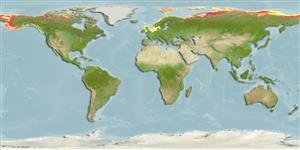>
Salmoniformes (Salmons) >
Salmonidae (Salmonids) > Coregoninae
Etymology: Coregonus: Greek, kore = pupils of the eye + Greek, gonia = angle (Ref. 45335).
More on author: Pallas.
Environment: milieu / climate zone / depth range / distribution range
Ecologia
marinhas; Água doce; estuarina; anádromo (Ref. 51243). Polar; 84°N - 49°N, 8°W - 95°W
Europe: All drainages (except Ob and Baikal) of Arctic Ocean in Eurasia from Mezen eastward. North America: Cape Barrow to Coronation Bay. Introduced in many localities of former USSR, but not established (Ref. 59043).
Length at first maturity / Tamanho / Peso / Idade
Maturity: Lm ? range ? - ? cm
Max length : 65.0 cm SL macho/indeterminado; (Ref. 59043); common length : 47.0 cm TL macho/indeterminado; (Ref. 12193); Idade máx. registada: 12 anos (Ref. 59043)
Espinhos dorsais (total): 0; Raios dorsais moles (total): 10-12; Espinhos anais 0; Raios anais moles: 12 - 14; Vértebras: 64 - 67. Distinguished by the pale or colorless pelvic fins, a terminal mouth and the presence of 41 to 48 gill rakers on the 1st gill arch (Ref. 27547). Dorsal fairly high and slightly falcate; pelvic with axillary process (Ref. 27547). Brown to dark greenish above fading to silvery on sides and belly; fins pale (Ref. 27547).
Occurs in brackish waters (20-22 ppt) of coastal lagoons and mouths of rivers and bays (Ref. 4779). Mostly in larger lowland rivers (Ref. 59043). Nerito-pelagic (Ref. 58426). Feeds on small crustaceans, insects, small fishes (Ref. 28219, 28857), worms and clams (Ref. 58426). At sea, feeds on larger crustaceans and small fish (Ref. 59043). No feeding occurs during the upstream migration (Ref. 4779). Lives 10 -12 years, rarely up to 20 (Ref. 59043). Enters rivers in shoals to spawn (Ref. 4779). Spends 6-8 years at sea before maturing and returning to rivers in June - July, to spawn in September - October of same year. A second run in autumn; those fishes remain a year in rivers before spawning. Moves far upstream, sometimes our to 1500 km. Spawns in shallow tributaries with some current in well oxygenated water over gravel bottom. Individual females do not spawn every year; spawns only 2-3 times during entire life. After spawning adults return directly to sea. Embryonic development lasts up to 7 months. Alevins migrate downstream in May - June (Ref. 59043). Collected by fyke nets (Ref. 4526). An important commercial species, but catches and abundance markedly reduced in last years (Ref. 59043).
Mature adults migrate upstream in the summer and may cover as much as 1,000 km (Ref. 28219) to spawn over gravel in fairly swift water. After spawning, adults return downstream. Young probably hatch in the spring and descend rivers into estuaries (Ref. 27547). Coregonus autumnalis do not breed yearly (Ref. 28219, 28220).
Wheeler, A., 1992. A list of the common and scientific names of fishes of the British Isles. J. Fish Biol. 41(suppl.A):1-37. (Ref. 5204)
Categoria na Lista Vermelha da IUCN (Ref. 130435)
Ameaça para o homem
Harmless
Utilização humana
Pescarias: espécies comerciais
Mais informação
ColaboradoresFotografiasStamps, Coins Misc.SonsCiguateraVelocidadeTipo de nataçãoÁrea branquialOutras referênciasCérebrosVisão
Ferramentas
Relatórios especiais
Descarregue XML
Fontes da internet
Estimates based on models
Preferred temperature (Ref.
123201): -1.7 - 3.4, mean -0.4 °C (based on 988 cells).
Phylogenetic diversity index (Ref.
82804): PD
50 = 0.5000 [Uniqueness, from 0.5 = low to 2.0 = high].
Bayesian length-weight: a=0.00468 (0.00405 - 0.00540), b=3.22 (3.18 - 3.26), in cm total length, based on LWR estimates for this species (Ref.
93245).
Nível Trófico (Ref.
69278): 3.7 ±0.2 se; based on diet studies.
Resiliência (Ref.
120179): Baixo, tempo mínimo de duplicação da população 4,5 - 14 anos (tm=6; Fec=2,000).
Prior r = 0.40, 95% CL = 0.26 - 0.60, Based on 1 stock assessment.
Fishing Vulnerability (Ref.
59153): Moderate to high vulnerability (52 of 100).
Nutrients (Ref.
124155): Calcium = 16.1 [7.0, 29.2] mg/100g; Iron = 0.468 [0.222, 0.892] mg/100g; Protein = 18.3 [17.2, 19.5] %; Omega3 = 0.693 [0.272, 1.906] g/100g; Selenium = 11.8 [4.4, 30.8] μg/100g; VitaminA = 6.52 [1.07, 40.50] μg/100g; Zinc = 0.432 [0.329, 0.617] mg/100g (wet weight); based on
nutrient studies.
